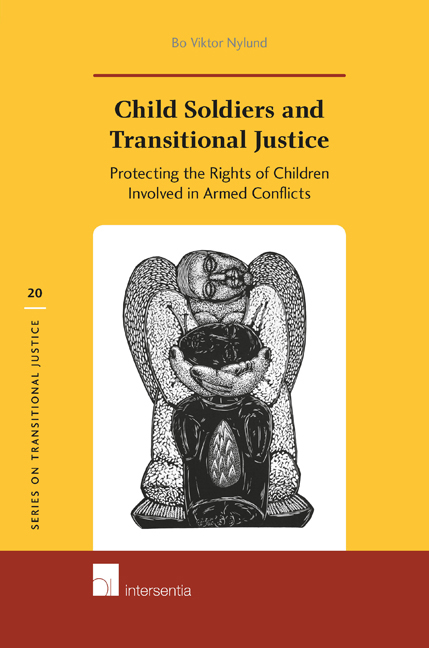 Child Soldiers and Transitional Justice
Child Soldiers and Transitional Justice Book contents
- Frontmatter
- Acknowledgements
- About the Author
- Contents
- List of Abbreviations
- Chapter 1 Objective, Scope, and Transitional Justice as an Analytical Framework
- Chapter 2 Child Recruitment and the Rule of Law: International Law and the Prohibition against Recruiting and Using Children to Take Direct Part in Hostilities
- Chapter 3 Child Recruitment and Criminal Justice: the Lubanga Case
- Chapter 4 Child Recruitment and Historical Justice: the Security Council Mechanism on Monitoring and Reporting
- Chapter 5 Child Recruitment and Reparatory Justice: Recovery and Reintegration of War-Affected Children
- Chapter 6 Child Recruitment and Institutional Justice
- Chapter 7 Children Involved in Armed Conflict and Participatory Justice: Balancing Rights and Responsibilities
- Chapter 8 Conclusions: Transitional Justice and the Potential for Stronger Protection of the Rights of Children Involved in Armed Conflicts
- Annexes
- Bibliography
Chapter 6 - Child Recruitment and Institutional Justice
Published online by Cambridge University Press: 12 December 2017
- Frontmatter
- Acknowledgements
- About the Author
- Contents
- List of Abbreviations
- Chapter 1 Objective, Scope, and Transitional Justice as an Analytical Framework
- Chapter 2 Child Recruitment and the Rule of Law: International Law and the Prohibition against Recruiting and Using Children to Take Direct Part in Hostilities
- Chapter 3 Child Recruitment and Criminal Justice: the Lubanga Case
- Chapter 4 Child Recruitment and Historical Justice: the Security Council Mechanism on Monitoring and Reporting
- Chapter 5 Child Recruitment and Reparatory Justice: Recovery and Reintegration of War-Affected Children
- Chapter 6 Child Recruitment and Institutional Justice
- Chapter 7 Children Involved in Armed Conflict and Participatory Justice: Balancing Rights and Responsibilities
- Chapter 8 Conclusions: Transitional Justice and the Potential for Stronger Protection of the Rights of Children Involved in Armed Conflicts
- Annexes
- Bibliography
Summary
If I were the president, I would talk to the rebel group leaders and build peace amongst the different ethnic groups. It does not make sense to fight this war.”
INTRODUCTION
Institutional justice considers reform of “public institutions that helped perpetuate conflict or repressive rule.” The laws and policies implemented through institutions at various levels are themselves the engine of change. Law can help distribute power more effectively and build or reform fair and efficient public institutions.
While criminal sanctions are generally predicated on individual criminal responsibility, civil sanctions of an administrative nature are based on exclusionary conditions, chiefly of political loyalty, which, for example, systematically disqualifies certain groups of people from participation in the new government. But changes of an institutional and administrative nature may also be part of an overall effort to change the way institutions operate and interrelate. In the Secretary-General's report taking stock of progress made in the rule of law and transitional justice arenas, emphasis is placed on institution building that provides for greater levels of national ownership, more concerted efforts at sector-wide approaches, and more emphasis on initiatives to facilitate access to justice.
Key legal questions that are considered in this chapter include:
– What does institutional justice signify in the context of the recruitment and use of children? What institutions are most important to safeguarding their rights?
– What areas of law in current contexts of child recruitment have developed during recent years, and how have they evolved?
– What role could business play in respecting and supporting children's rights within a context of child recruitment and transitional justice?
– What are the entry points in this otherwise big-picture area of transitional justice for issues related to children?
Much of what is implemented as part of institutional justice oft en has its beginning in early parts of the peace process, including ceasefire and peace agreements. An example of this type of transformation is the signing, in 2006, of the peace agreement for Darfur, where the Sudan Liberation Army leader became a vice-president as part of the peace agreement discussions.
- Type
- Chapter
- Information
- Child Soldiers and Transitional JusticeProtecting the Rights of Children Involved in Armed Conflicts, pp. 163 - 186Publisher: IntersentiaPrint publication year: 2016


